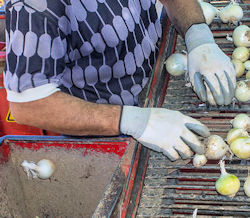Risk Factors Inherent in the Task
Repetition
Repetition is a measure of how frequently we complete the same motion or exertion during a task. Managers and office workers can suffer from repetitive motion injuries, especially at the wrist from using a mouse and continual typing. The severity of repetitive motion injuries depends on:
- the frequency of repetition,
- speed of the movement or action,
- the number of muscle groups involved, and
- the required force during movement.
Food processors repeatedly handling products while working on conveyor lines suffer from repetitive motion issues. The more the joint departs from the neutral position, the greater the likelihood of injury.
Recovery Time
Recovery time is a measure of the rest (or low stress activity) period available to the muscle group between similar exertions. Recovery time is important in preventing muscle fatigue because oxygen and metabolites are allowed to rejuvenate while uric acid and other waste products are removed from the muscle group. Recovery time needed will lengthen as the duration of the task increases.
Duration
Duration is a measure of length of time of exposure to a risk factor. Of course, the assumption is that the longer the duration of exposure, the greater the risk of injury. Duration may be measured in seconds, minutes, hours, days, weeks, months, and even years. Food processors handling products while working on conveyor lines may suffer from injuries due to the duration (long hours) of work.
As with most individual risk factors, duration must be considered along with other people, task, and environmental risk factors such as the physical conditioning of the worker, posture, force, weight, temperature, stress, etc.
Knowledge Check Choose the best answer for the question.
1-4. Who is most likely to suffer from repetitive motion issues in the workplace?
You forgot to answer the question!

